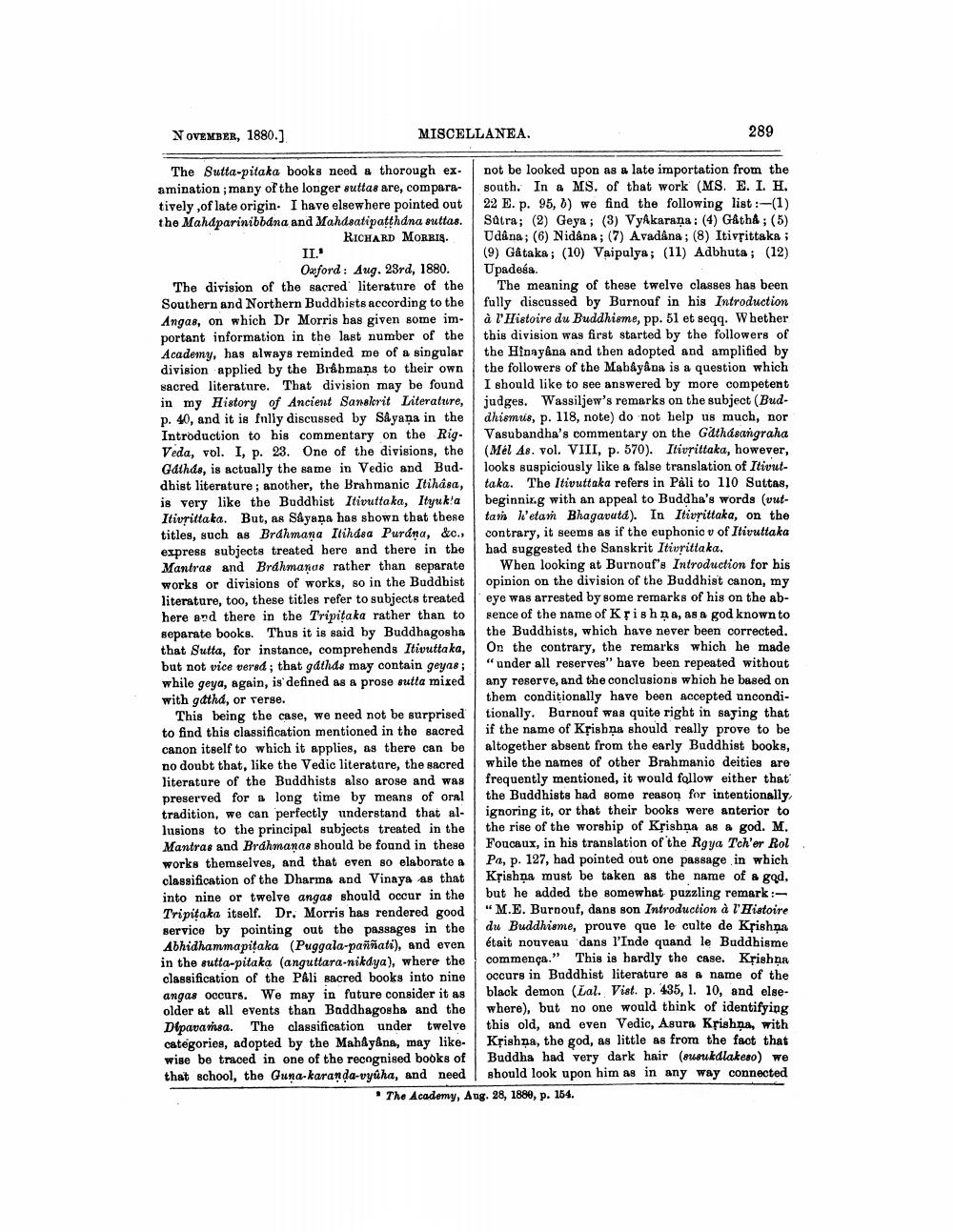________________
NOVEMBER, 1880.]
MISCELLANEA.
289
II.
The Sutta-pitaka books need a thorough ex- not be looked upon as a lato importation from the amination; many of the longer suttas are, compara- south. In a MS. of that work (MS. E. I. H. tively,of late origin. I have elsewhere pointed out 22 E. p. 95, 0) we find the following list :-(1) the Mahaparinibbana and Mahdsatipatthana suttas. Satra; (2) Geya; (3) VyAkarana : (4) GÅthA; (5)
RICHARD MORRIS. Udana; (6) Nidana; (7) Avadana; (8) Itivsittaka ;
(9) Gataka; (10) Vaipalya; (11) Adbhuta; (12) Oxford: Aug. 23rd, 1880. Upadesa. The division of the sacred literature of the The meaning of these twelve classes has been Southern and Northern Buddhists according to the fully discussed by Burnouf in his Introduction Angas, on which Dr Morris has given some im-1 à l'Histoire du Buddhisme, pp. 51 et seqq. Whether portant information in the last number of the this division was first started by the followers of Academy, has always reminded me of a singular the Hinayana and then adopted and amplified by division applied by the Brahmans to their own the followers of the Mabayana is a question which sacred literature. That division may be found I should like to see answered by more competent in my History of Ancient Sanskrit Literature, judges. Wassiljew's remarks on the subject (Budp. 40, and it is fully discussed by Sâyana in the dhismais, p. 118, note) do not help us much, nor Introduction to his commentary on the Rig. Vasubandha's commentary on the Gathasangraha Veda, vol. I, p. 23. One of the divisions, the (Mel As. vol. VIII, p. 570). Itivrittaka, however, Gathds, is actually the same in Vedic and Bud. looks suspiciously like a false translation of Itivutdhist literature, another, the Brahmanio Itihasa, taka. The Itivuttaka refers in Páli to 110 Suttas, is very like the Buddhist Itivuttaka, Ityuka beginning with an appeal to Buddha's words (vutItivrittaka. But, as Sayana has shown that there tan Wetan Bhagavatd). In Itivrittaka, on the titles, such as Brahmana Itihasa Purana, &c. contrary, it seems as if the euphonic v of Itivuttaka express subjects treated here and there in the had suggested the Sanskrit Itivrittaka. Mantras and Brahmanus rather than separate When looking at Burnouf's Introduction for his works or divisions of works, so in the Buddhist opinion on the division of the Buddhist canon, my literature, too, these titles refer to subjects treated eye was arrested by some remarks of his on the abhere and there in the Tripitaka rather than to sence of the name of Krishna, as a god known to separate books. Thus it is said by Buddhagosha the Buddhists, which have never been corrected. that Sutta, for instance, comprehends Itivuttaka, On the contrary, the remarks which he made but not vice vered; that gathds may contain geyas; "under all reserves" have been repeated without while geya, again, is defined as a prose sutta mixed any reserve, and the conclusions which he based on with gatha, or Terse.
them conditionally have been accepted uncondiThis being the case, we need not be surprised tionally. Burnouf was quite right in saying that to find this classification mentioned in the sacred if the name of Krishna should really prove to be canon itself to which it applies, as there can be altogether absent from the early Buddhist books, no doubt that, like the Vedic literature, the sacred while the names of other Brahmanio deities are literature of the Buddhists also arose and was frequently mentioned, it would follow either that preserved for a long time by means of oral the Buddhists had some reason for intentionally tradition, we can perfectly understand that al- ignoring it, or that their books were anterior to lusions to the principal subjects treated in the the rise of the worship of Krishna as a god. M. Mantras and Brahmanas should be found in these Foucaux, in his translation of the Roya Toh'er Rol works themselves, and that even so elaborate a Pa, p. 127, had pointed out one passage in which classification of the Dharms and Vinaya as that Kțishņa must be taken as the name of a god, into nine or twelve angas should occur in the but he added the somewhat puzzling remark: Tripitaka itself. Dr. Morris has rendered good
"M.E. Burnouf, dans son Introduction à l'Histoire service by pointing out the passages in the du Buddhisme, prouve que le culte de Krishna Abhidhammapitaka (Puggala-paññati), and even était nouveau dans l'Inde quand le Buddhisme in the sutta-pitaka (anguttara-nikdya), where the commenga." This is hardly the case. Krishna classification of the PAli sacred books into nine occurs in Buddhist literature as a name of the angas occurs. We may in future consider it as black demon (Lal. Vist. p. 435, 1. 10, and elseolder at all events than Baddhagoshs and the where), but no one would think of identifying Dipavansa. The classification under twelve this old, and even Vedic, Asura Krishna, with catégories, adopted by the Mahayana, may like- Krishna, the god, as little as from the fact that wise be traced in one of the recognised books of Buddha had very dark hair susukdlakeso) we that school, the Guna-karanda-vyúha, and need should look upon him as in any way connected
• The Academy, Ang. 28, 1880, p. 154.




